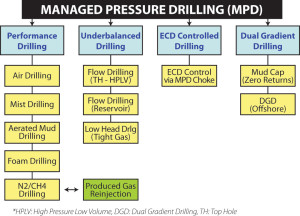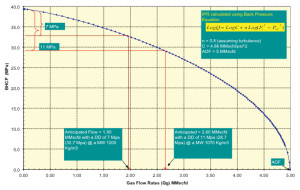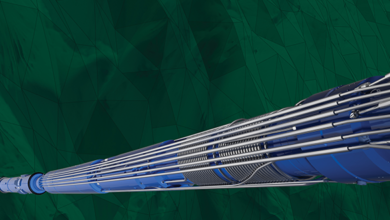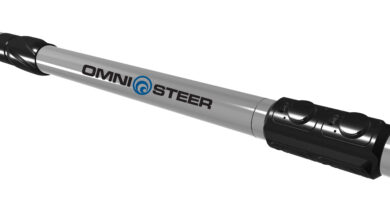Upfront planning, operational strategy key to MPD success
By Hassan Malik, Evantage Energy Inc

Unlike underbalanced (UBD), managed pressure drilling (MPD) operations are sometimes “taken lightly” due to its nature of being slightly above or at balance with reservoir pressures. This author believes that successful MPD jobs over the years may have lulled the industry into assuming MPD technology is simply applied.
Another factor driving this trend is the fact that, in the case of failure, the kill mud weight is there to continue operations using conventional drilling methods. This is promoting a technical culture that does not adequately emphasize proper screening, engineering design and operations strategy prior to an MPD-styled well. As such, MPD can often be seen as simply adding a choke manifold and a rotating control device (RCD). This approach may be successful in some situations, but it can also lead to serious operational challenges. Well integrity can be jeopardized, and it can create a hazardous working environment.
The focus of this article is to outline an approach that highlights a stage-gate process toward MPD projects in order to ensure success when applying MPD technology.
A typical sequence of MPD project management and planning is:
1. Screening
2. Geology and stress regimes in the wellbore
3. Estimation of reservoir pressure
4. Inflow performance relationship (IPR) prediction
5. Flow modeling
6. Drilling operations strategy
7. Well control matrix
8. Training matrix
9. HAZID and HAZOP
10. Process flow diagrams
In many instances, time constraints do not allow a full and detailed engineering and operations design. The results can be poor planning, operational personnel not understanding their responsibilities, an undefined communication hierarchy, and operator reliance on vendors.
This author would like to point out that, without sufficient upfront planning or a clear understanding of the challenges in an MPD operation, operational personnel can suffer from “MPD Amnesia.” MPD Amnesia is a state where, for a moment in time, a critical decision is made by personnel during an unconventional drilling operation using conventional drilling logic.
This article shall highlight some of these variables to show how MPD projects are affected when a lack of understanding in pre-planning is prevalent. The article will also show what can happen when personnel believe that simply having an RCD and MPD choke can get the job done while neglecting the basic tenets of MPD project planning.
Lastly, the article will detail lessons that have been learned from case histories around the world and attempt to clarify common misconceptions around MPD.
What is MPD?
According to IADC, managed pressure drilling is an adaptive drilling process used to more precisely control the annular pressure profile throughout the wellbore. The objectives of MPD are to ascertain the downhole pressure environment limits and to manage the annular hydraulic pressure profile accordingly. MPD is intended to avoid continuous influx of formation fluids to surface.
The premise of MPD is to successfully drill a well by reducing NPT, whether in the form of ROP, additional casing strings, mud weight (MW) control, ballooning or lost circulation. In the underbalanced drilling mode, although there is light MW present in the hole, the reservoir is flowed while drilling. This is also called “flow while drilling.”
Both MPD and UBD are frequently used in the industry – often in combination with each other. To clear up any confusion, Figure 1 shows the nomenclature associated with each technique and simplifies how they can be pictured under one umbrella.
MPD project delivery approach
For a typical MPD project, the project planning includes items and variables that are most relevant to the engineering, planning and operations design. This section examines items that are frequently discussed in an MPD project.
1. Screening of troublesome well sections
Due to the unique nature of MPD and UBD, well sections require a thorough screening. This can be done on a basic level, such as simplified screening forms, to more advanced levels. The goal of screening is to ensure:
• Main driver to implement MPD is cleared in a given section;
• Well section is placed under the correct technique as illustrated in Figure 1;
• Type of sub-technique that may be relevant to that well section;
• Added benefits, such as a ROP, less time to drill are highlighted;
• The level of detail that an MPD program may require;
• Experience level within the operator and on the rig site (critical action item);
• Rig selection, such as spacing below the rotary table to fit the RCD; and
• Quick look data to run flow modeling.
2. Understanding of geology and stress regimes in the wellbore
• Lithological information, such as compressive strength, wellbore stability or collapse pressure and fracture gradient (FG), is very useful.
• In some areas, there is now a concept of “walking the line,” showing a tight window between pore pressure and formation FG.
• FG value is very important in an MPD scenario as the well is subjected to high ECD values. In some cases, FG is deliberately reached to confirm the threshold FG value of the formation.
• Permeability in tight gas or oil shale plays may not play a vital role, but for high-pressure, high-temperature (HPHT) wells, good near-wellbore permeability can be important. A good near-wellbore permeability in an HPHT well can assist in determining the value of reservoir pressure by conducing mini-drawdown tests.
• Fracture network and how prolific these fractures are in terms of giving influx or acting as lost-circulation zones is an important variable that should be understood prior to entering the formation.
3. Getting a good estimation of reservoir pressure
• It is critical to have a good estimation of the reservoir pressure.
• MPD can assist in determining the reservoir pressure as long as there is near-wellbore permeability. The method of “mini-drawdowns” at the sandface can be very useful to estimate reservoir pressure.
• Once there is influx, the well can be choked again to bring back the original drilling ECD.
4. IPR prediction using production or well testing data
• The IPR is ignored when MPD wells are planned.
• Plotting IPR for an MPD well is only to produce an estimate such that, if there is any influx, how significant that influx can be and how it can effect the MACP should there be any surface applied choke pressure (SACP).
• IPR is simply the reservoir potential and is plotted against BHCP vs expected flow (BHCP vs Q), where Q can be related to either gas or oil.
• A simple approach of nodal analysis can be taken to predict the expected influx in an MPD operation, which is slightly different from the UBD perspective.
• Instead of using tubing/outflow performance curves, drilling mud weight is used to predict the expected HC influx that may occur in a worst-case scenario (Figure 2).
• In other words, IPR is only drawn in an MPD well is to simulate the variation in SACP based on the value of an influx from the reservoir. The value of influx is not significant and can be represented in the form of m3. The goal of Figure 2 is to show how to predict a gain in a prolific reservoir when there is hydrostatic pressure of the mud at the sandface.
• All efforts in an MPD operation is not to take any flow while drilling or while making connection or with any other operation.
5. Conducting single or multiphase flow modeling to predict wellhead pressures (WHP)
• MPD relies mainly on single-phase flow models. There is a misconception that because flow while drilling is not encouraged in an MPD well, there shall be no gas in the well too. However, every well contains some gas, and MPD is no different. Just as there is connection gas in a conventional well, MPD wells can have connection gas or slugs too.
• Flow models can also predict SACP when the pumps are off or when making a connection. Generally, this value is simply the addition of total friction loss plus SACP while drilling.
• It is from here that fountain curves or a profile regarding ECD along the length of the wellbore is drawn. Fountain curves are particularly useful, especially when there is a risk of fracturing the formation. This risk of fracturing can either be in the main hole or in the exposed uphole sections when the target zone is drilled
6. Developing a drilling operations strategy with added equipment on surface
• This is often the most uncomfortable topic from a planning perspective, especially for the rig crew. Added equipment alters their comfort level, or some see it as more work added to their day.
• MPD equipment is worked differently than rig equipment. A common strategy is crucial when MPD equipment is placed onsite; process flow diagrams (PFDs) are a way to illustrate the operations strategy.
• BOP drills should be run in conjunction with the MPD operation and equipment.
7. Building a well control matrix using MACP and pressure rating of the RCD
• MACP and MPD go hand in hand. A well control matrix using WHP versus the rating of the RCD is crucial for any MPD operation.
• Well control matrix draws the line of when to switch from MPD mode to conventional well control. This is an absolute must to understand if a kick is taken while drilling.
• The theme of well control matrix revolves around the dynamic rating of the head. If any gain or influx can reach 75% of the dynamic rating, this should be an alarm bell for the operation. If this occurs, the well should not be drilled in an MPD mode, and conventional well control must be pursued to kill the well.
• Many softwares do not have the capability of simulating small-volume kicks. However, many vendors have the capability of drawing a well control matrix, which is incorporated in the main MPD program. This matrix must be followed strictly and must be discussed in DWOPs, HAZID and HAZOPS, the training matrix and before spudding the MPD section.
8. Training of Personnel
• Many operators rely on vendors to conduct training for their personnel, although some companies have designed their own “training matrix” that is run on unconventional-styled wells.
• The idea of training is to ensure that the rig crew and operations staff understand the importance of the operation and are comfortable with the additional equipment on surface.
• The training matrix is important in breaking the ice between the rig crew and the MPD vendor. Both need to understand their roles and liability issues associated with each other’s equipment.

Case histories
Example 1: MPD Amnesia
A practical example of “MPD Amnesia” was seen in a reservoir prone to ballooning. Unfortunately, high MW in a ballooning reservoir only brought more ballooning, resulting in more gas units while drilling or tripping.
Slugs also are very common in formations prone to ballooning and can often be seen in UBD operations. However, in an MPD operation, slugs typically occur in fractured reservoirs. As drilling continues and the wellbore is subjected to pressure fluctuations – either by pumps on/off, by circulating high-viscosity pills or by circulating heavy MW – these slugs accumulate downhole.
In a recent MPD operation, an operator applied MPD only in the target formation, which was notorious for ballooning. MPD drilling commenced with no problems. The training matrix was thoroughly run, and communication was well covered between the rig crew and MPD vendor personnel.
While drilling, pump #1 broke down. A frustrated driller rushed to fix the problem but failed to inform the MPD choke operator. At the same time, the MPD choke operator failed to acknowledge on the side screen that pump strokes were zero.
It took the driller 1 min 20 secs to switch from pump #1 to pump #2. During this time, the choke was wide open, resulting in a complete loss of ECD at the sandface and the pressure that was applied on the formation was simply the hydrostatic head of mud column that was static at the time. As drilling commenced again, slugs were circulated to surface, resulting in flooding at the shaker.
The driller had fallen into MPD Amnesia and made the decision to reduce the pump rate from 0.9 cu meter/min to 0.7 cu meter/min. It seemed the slugs were amplified by the ballooning of the well. The driller later decided to decrease the pump rate to 0.5 cu meter/min; this resulted in a further loss of ECD at the sandface, making the operation an UBD type than an MPD one.
This process lasted for 1 hour and 10 mins, within which the well took a 10-cu-meter kick and conventional well control had to be called.
Throughout this shaker-flooding event, no additional SACP was applied by the choke operator as everyone focused on mitigating the flooding at the shaker rather realizing that they are in an MPD mode.
Example 2: Well Control Matrix was defined but was not followed at the time of drilling
An operator was drilling his second well using an MPD technique and relied heavily on the service company. The service company had extensive experience in the area, in both MPD and UBD. The HAZID and HAZOP related to the MPD operation was discussed in detail in planning and pre-spud meetings.
The operator decided to bypass the MPD equipment to keep the operation conventional. It was also decided to switch to the MPD equipment if there is a significant gain in pit volume or gas volume increases. During the drilling operation, the crew noticed minute pit gains but ignored them. When the pit gains became more frequent, it was decided to shut in the well and stop drilling for a flow check.
When conducting the flow check, the well was found to be flowing. The MW was increased, and drilling continued normally with heavy MW. No significant pit gain was noticed.
When an abnormally pressured zone was encountered, a significant pit gain resulted.
The operating company representative decided to divert the flow to the MPD equipment without realizing that, from the well control matrix standpoint, every RCD has a dynamic and static operating limit.
The No. 1 rule in the well control matrix was ignored, and the well was again shut in for a flow check. It was confirmed that well was flowing.
Rather than killing the well conventionally, it was decided to flow the well to the MPD equipment to divert the influx to the MPD separator. Unfortunately, the pressure at the bottom of the bearing assembly was more than it could hold; on diverting the well effluent mix with gas through the 4-in. line off the RCD, it simply could not bear the pressure, and the rig was set on fire due to gas migration from the 4-in. line.
Fortunately, nobody was hurt, but a relief well had to be drilled to kill the well.
Example 3: Use of high mud weights in an MPD operation
The operator started to drill a high-pressure formation using MPD. The MW was roughly 100 Kg/cu meter lower than the reservoir pressure. Once drilling started, a fracture was hit. The fracture itself was not very productive, and the gas was circulated out of the well through the MPD equipment.
The well later struck another fracture, this time gaining approximately 1 cu meter of fluid. The company decided to increase the MW by 80 Kg/cu meter while keeping the same SACP. The increment of MW to a further 50 Kg/cu meter without lowering the SACP value resulted in extremely high ECDs at the sandface that crossed the fracture gradient of the formation.
There was a total loss of communication between all parties on the rig, and the well underwent fracturing. On occurring of mud loss, LCM was pumped through the mud to cure losses, but it appears to have only aggravated the situation. The well had to be TD’d earlier, 450 meters short of planned TD.
Conclusion
Upfront planning for an MPD well, especially in a new area, can be challenging and operationally demanding. The training of the rig crew alongside the operator’s and vendor’s personnel should always be kept high on the agenda. The training should not only be limited to the classroom but should encompass a practical approach, such as involving the rig crew so they understand why MPD is being applied in a given section. Some companies, before the operation starts, do a walkaround of their MPD equipment and explain its purpose. Many rig crews find an autochoke fascinating. Currently many operations have members of the rig crew do the job for changing out the bearing assembly or clamping it on RCD bowl.
Some companies have gone a step further to offer a cause, effect and action matrix that they discuss in every safety meeting before the well goes into the MPD phase. They even offer “fountain curves” for the company representative onsite whereby he or she can check ECD profile with reference to depth at any given time. A handy “fountain curve” also helps the company representative to talk the language of the MPD field engineer onsite; this develops a positive relationship between working parties, hence a smooth operation.
Finally, one needs to go through a number of wells to achieve a comfort level. There have been operators that followed a detailed procedure of applying MPD on their wells, but after a number of successful attempts they realized that their wells may only require an RCD. To date, they have cut down the cost of the wells by more than 45%. The cost of MPD alone in the beginning was slightly higher, but the overall gain in well performance offset the MPD cost. Further, after drilling several wells, only a simple RCD is used, with no choke or separator.
Acknowledgements: The author would like to acknowledge his mentor Dennis Moore from Marathon Oil Company and Late Steve McCoy from ConocoPhillips, who was a big advocate of this topic. Finally, to Calgary Islamic School’s principal Moussa Ouraou and A. Ila, who accommodated the author and provided a venue to finish this article.
This article is based on a presentation at the 2013 SPE/IADC MPD & UBO Conference & Exhibition, 18-19 April, San Antonio.




